If we assume that people’s interests vary according to the time of day, your website might be well served by promoting different kinds of content depending on whether its day or night. For example lets say we have two articles, one about the sun eventually burning out, and one about the Hale-Bopp comet. We can […]
Category Archives: Tutorials
Make Life Easier With Custom Photoshop Actions
Once you start working with Photoshop for some time you’ll find that your projects require many of the same, repetitive, actions and tasks. By creating custom actions for your more routine tasks, you’ll have more time to focus on your image. Creating a custom action is relatively easy, so in this tutorial I am going […]
Getting Ready For Video (Video Filters)
Just as in print, not all the colors you see on a computer monitor can be reproduced correctly on video. If you are preparing overlays or graphics for TV or video, you can use the NTSC filter from your Video submenu to make your graphics broadcast safe. Take a look at the following graphic before […]
The Pen Tool
The pen tool is an extremely valuable feature in Photoshop – however often overlooked by most people due to a simple lack of understanding how all of it’s components really work. I will attempt to breakdown the various options and features of this tool and hopefully help to provide a better understanding for what it […]
Editing Colors Within A Photo
A common task in Photoshop is the need to change a specific color in a photo, may it be a person’s hair or eye color. In this tutorial I will go over two different methods you can use to change the colors within a photo. Each method has its own advantages and disadvantages – so […]
Triangles
Continuing on with shapes and Photoshop I wanted to touch base upon triangles. Photoshop doesn’t have a built in triangle tool, so drawing a triangle takes a bit more work than the circles and squares took. Here we will use Photoshop’s line and arrowhead feature to create various triangles. We’ll start off by double clicking the line […]
Circles and Squares
Shapes are probably the simplest and most common starting point for Photoshop users – and one of the most common beginner questions I get asked is “how do I draw a perfect circle?”. In this tutorial I attempt to answer that question – along with the usual follow-up of “and what about a perfect square?”. […]
Square CSS Badges
[frame align=”left”][/frame]I was playing around with CSS earlier today and came up with something rather interesting, I call them CSS badges since I’m really not sure what else to call them.The code behind these buttons is actually extremely simple and I have commented it along the way so you could easily see what controls what. […]
Programming In C: Functions with Viewer Choice
Using a Conditional inside a User-Defined Function If you want to give the viewer a choice of options, this can be handled either inside a user-defined function, or in the main( ) function. Let’s begin by handling viewer choice inside a user-defined function. In this example, a customer chooses how many books to order. The […]
Programming In C: Built In & User Defined Functions
There are several different types of functions in C. So far, we have used one type of function – the built-in C functions, like printf( ) and scanf( ). These functions are part of the C programming language. Another type is called a user-defined function. This is a function which the programmer creates and uses in a […]
Programming In C: Character Type Library Functions
Character Type Header File If you need to check what type of character the viewer typed, use ctype.h which is the character type header file. We write it like this: #include<ctype.h> Here is a list of character type library functions: isalpha checks if the input is an alphabetical letter isdigit checks if the input is a number […]
Programming In C: More Library Functions – strcmp, stricmp, strcat, strstr
strcmp: compare two strings You can compare the characters and spaces in a string using the strcmp function. For example, is “William Lambton” the same as “William Lamberton”? Using strcmp, the computer will compare each character and space, to see if they are identical. If the names are the same, the computer will return a value of […]
Programming In C: Library Functions for Strings – strcpy, strlen
C Library Functions for Strings C comes with libraries of special functions, that we can use in our programs. These functions are stored in the string header file, <string.h>, which we include at the beginning of our program: #include<string.h> Here is a list of string library functions: strcpy copies a string strlen calculates the length […]
Programming In C: Declaring Strings & Gets and Puts Functions
Declaring (Initializing) Strings As we learned in the lesson on Characters and Strings, a string is a character variable with more than one character. Strings can be abbreviations, words, phrases, sentences, or even paragraphs. To declare a string, use the char variable type, then specify how many characters are in the string. Add one to this number, because […]
Programming In C: Using a Pointer to Change the Value of a Variable
Declaring (Initializing) Pointers As we learned in the previous lesson, a pointer contains the address of a variable. Different types of variables have different types of pointers. For example, an integer variable will have an integer pointer; a float variable will have a float pointer. Pointers can be variables too. You can declare a pointer at […]
Programming in C: Information Storage, Variable Addresses and Viewer Input
Information Storage We know that computers store information in memory. Each byte of information has a specific location in the memory area. This location is called the address. Whenever you use a variable, the value of the variable is stored in a specific address. This is why we used the ampersand & with the scanf […]
Computer Number Systems
Bits and Bytes Computers store information in bits, which are labeled 0 (empty) or 1 (full). A set of 8 bits is called a byte, like this: 1010 0010 Each byte has an address, which is labeled with a hexadecimal number, like this: C7.
Programming In C: Counting Array Elements & Sizes
Size of an Array How much space in memory does an array occupy? We can calculate this by using a special operator: sizeof. This operator calculates how many bytes of memory are occupied by an array. For example, here is an array: numbers[3] = { 8, 29, 63 }; Using sizeof, I can write: printf(“The numbers array […]
Programming In C: Array of Arrays
Array of Arrays If you have several arrays, you can combine them into an array of arrays. This is a large array that consists of two or more small arrays. For example, let’s say I have two arrays, each with three elements: first[3] = { 11, 17, 23 }; second[3] = { 46, 68, 82 }; […]
Programming In C: Arrays and Loops
Arrays and Loops If you need to perform a function on each element in an array, then use a for loop. Set the counter at 0, so that the loop will start with the array element in index 0, and then loop through each element of the array: for(i = 0; i < number of elements; […]









